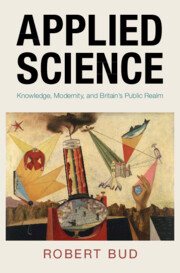Book contents
- Applied Science
- Science in History
- Applied Science
- Copyright page
- Dedication
- Contents
- Figures
- Acknowledgements
- Introduction
- Stage 1 Origins and Pedagogy in the Nineteenth Century
- Stage 2 Research in the Early Twentieth Century
- 4 The Dawn of the Twentieth Century
- 5 From the Magi to Industrial Function
- 6 ‘Western Civilisation’ and Applied Science
- Stage 3 After World War Two
- Archives Used
- References
- Index
5 - From the Magi to Industrial Function
from Stage 2 - Research in the Early Twentieth Century
Published online by Cambridge University Press: 15 March 2024
- Applied Science
- Science in History
- Applied Science
- Copyright page
- Dedication
- Contents
- Figures
- Acknowledgements
- Introduction
- Stage 1 Origins and Pedagogy in the Nineteenth Century
- Stage 2 Research in the Early Twentieth Century
- 4 The Dawn of the Twentieth Century
- 5 From the Magi to Industrial Function
- 6 ‘Western Civilisation’ and Applied Science
- Stage 3 After World War Two
- Archives Used
- References
- Index
Summary
In the struggle to sustain the nation’s economy and society accompanying World War One, the concept of ‘applied science’ was widely deployed and further enriched. It gained new traction through wartime and post-war administrative developments and the debates over research amongst the military services, civilian agencies, and private industry. Generic issues of the time were highlighted by the 1917 Sothern Holland enquiry into the organisation of naval research. Subsequently, new establishments, such as the DSIR and the Committee of Civil Research, shaped applied science. The chapter shows the interpretation of applied science by individual institutions and the press by exploring the details of specific research projects in the military, the radio industry and, above all, coal-oil manufacture. Thus it treats research on converting coal to oil at ICI, the Low Temperature Carbonisation Company, and Powell Duffryn. Through their thinking over funding priorities, new bodies often formulated and promoted their own conceptions of applied science. They both responded to public opinion and helped shape widely shared understanding.
Keywords
- Type
- Chapter
- Information
- Applied ScienceKnowledge, Modernity, and Britain's Public Realm, pp. 118 - 165Publisher: Cambridge University PressPrint publication year: 2024

